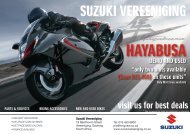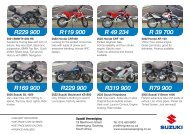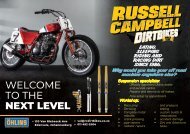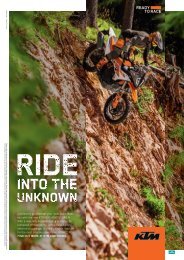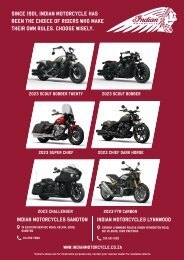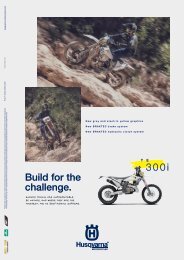Create successful ePaper yourself
Turn your PDF publications into a flip-book with our unique Google optimized e-Paper software.
down, which means lower<br />
inertia and the ability to work<br />
faster. Of course, we find a<br />
lot of elements covered with<br />
a DLC (Diamond Like Carbon)<br />
coating that reduces friction.<br />
It requires a lot of air for the<br />
engine to work at such high<br />
revs generating huge power.<br />
An impressive air intake at<br />
the front of the machine is<br />
responsible for delivering it. In<br />
order to provide uninterrupted<br />
inflow, the traditional ignition<br />
was abandoned in favour<br />
of a proximity key. Also<br />
the steering damper was<br />
removed from the upper<br />
shelf area (traditional place<br />
for Fireblade). The electronic<br />
cupid wondered off to the<br />
front of the bottom shelf.<br />
The airbox intake manifold is<br />
almost straight, which forced<br />
the use of a special shape of<br />
valves that force the mix to<br />
spin. Certainly there are many<br />
more interesting nuances in<br />
the engine, but the dinner with<br />
Mori-San is over, and we are<br />
more interested in how the<br />
new stove works in full flight.<br />
“The fastest 600 I’ve<br />
ever ridden”<br />
This statement by a British<br />
journalist says it all. Pay<br />
attention to the chart from<br />
the dynamometer (pictured<br />
far right), which clearly shows<br />
that in the low and medium<br />
rev range the previous<br />
Fireblade is even slightly<br />
stronger than the <strong>2020</strong> model.<br />
However, if the motorcycle<br />
is to be racing, no one is<br />
interested in average revs but<br />
more the low down, just like in<br />
600cc class.<br />
Finally, I turn on the display<br />
mode, in which the indications<br />
appear only from 5000 rpm<br />
and I start playing high engine<br />
spin. After exceeding 7,000<br />
rpm, a strong thrust appears,<br />
and after 11,000 rpm I got<br />
what we’ve all been waiting<br />
for all these years! The new<br />
Fireblade goes crazy!<br />
After the first session, I<br />
got off the bike and among<br />
my fellow editors I could see<br />
approving nods. Impressions<br />
are phenomenal! It’s a really<br />
furious Japanese machine! I<br />
shoot it, the exhaust system is<br />
screaming heavily, and I shift<br />
through the next gears with<br />
an incredibly fast quickshifter!<br />
To play with gears I have to go<br />
“Honda engineers used the RC213V-S MotoGP inspired road-going<br />
machine as the performance benchmark for the development of<br />
the new Fireblade, which also draws on the RC213V-S for most of<br />
its new technology.”<br />
really fast. I pull first gear to 170<br />
km/h, second to 220 km/ h, and<br />
I catch fourth on 299 km/ h!<br />
It’s a pity that the motorcycle is<br />
limited to the aforementioned<br />
299 km/h. Certainly, someone<br />
will unlock it and check the<br />
maximum speed.<br />
The power comes linearly,<br />
and the electronic throttle<br />
is very precise, but with<br />
so much HP on board you<br />
need to be a pro to handle<br />
it without electronics. Most<br />
users, including myself, will<br />
enjoy traction control. The<br />
new Fireblade, in addition to<br />
using the six-plane Bosch IMU<br />
sensor, takes into account<br />
the speed of rear wheel slip.<br />
This means that the bike<br />
can now drive in controlled<br />
slides and sense when the<br />
loss of traction is in safety<br />
or not. Ultimately, I had the<br />
choice of either turning off<br />
the traction control and<br />
opening the throttle with a<br />
big handful at each exit, or set<br />
low levels of interference (1 or<br />
2) and try to find the optimal<br />
traction alone. I had to be<br />
careful then, because at full<br />
lean I felt the rear wanting to<br />
break traction. I control the<br />
throttle and the HSTC system<br />
guided me helping hone in<br />
my exuberance. On the Losail<br />
Above shows the dyno chart<br />
between old and new versions.<br />
Old being green and new being<br />
red. The way the new bike<br />
delivers the power is smoother<br />
and ultimately loads more.<br />
RIDEFAST MAGAZINE MARCH <strong>2020</strong> 69




